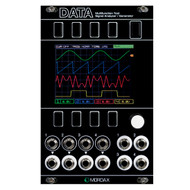Mordax - DATA
by Sam Chittenden
With the proliferation of desktop synths that feature some sort of integrated waveform display it can be frustrating to not have the same visual feedback available when playing around with sound in a Eurorack setting. Of course you don’t need a scope to have a rewarding experience and there are alternatives to having an oscilloscope in your rack but nothing beats the immediacy and tailored interface of a Eurorack oscilloscope. An arguably mandatory inclusion in any sized system, the Mordax Systems DATA is the Ferrari of Eurorack signal analyzers and is a proverbial Swiss army knife of a module. In addition to its gorgeous, precision 4-channel color oscilloscope, the DATA packs a host of other fantastically useful utilities into its 16hp.
First, the DATA's oscilloscope has four independent channels with a host of configurable parameters. DATA's shallow menu system allows access to each channel's voltage display scale [1, 2, or 5 volts per grid square], position [an offset allowing the trace to be shifted along the y-axis], AC or DC coupling, and an option to hide or display the channel's trace. Having any sort of visual feedback from your system is great. Having four entirely discrete channels makes for quick work when inspecting all manner of signals from envelopes, to LFOs, to waveshaping results, to any frequency or amplitude modulation experimentation you may have going on in a patch.
In addition to its oscilloscope the DATA has a plethora of other super useful utilities. Boasting not one but two spectral programs—a spectrum analyzer and a spectrograph—DATA provides two great ways to visualize a signal's frequency components. The spectrum analyzer displays these components in a kind of bar graph, separating small ranges into distinct bars whose height represents the magnitude of that frequency in the signal. Relatedly, the spectrograph analyzes the signal and represents it in color, the lighter the color the greater the magnitude. The spectrum analyzer is especially helpful for picking out what harmonic partials are present in a signal, especially with complex FM'd waveforms. The spectrograph can be great for sniffing out problem frequencies in a patch.
DATA has an onboard tuner as well, which is a pretty straightforward affair with a characteristically information rich interface. The tuner is great for getting all of your sound sources to play nicely with each other and helpful details like the name and frequency of the nearest note as well as the signal frequency and the difference between the two, allow for quick tune-ups. DIY enthusiasts will find the tuner accurate enough to calibrate newly built VCOs as well. Again, having the four channels really ups the convenience as multiple modules don't have to be patched and unpatched to use the tuner. Just toggle between each channel with the DATA's buttons and you're off and rolling.
Along with the aforementioned functions, the DATA can also produce its own waveforms. Two separate waveforms can be output at once, with frequencies ranging from LFO to VCO territory. Each waveform generator has 1V/Oct control and will track pitch over 8 octaves. You can choose between sine, square, triangle, or saw waves and the phase, amplitude, and offset of each waveform can be set. Additionally, DATA offers waveshaping capabilities [clipping and folding], further expanding the possibilities for interesting and novel LFOs or sound sources.
The DATA also clocks and unsurprisingly, does it well, with four different clock outputs. Replete with division and multiplication based off of either an internal base rate or an external sync, each channel can be independently offset from the base rate and there are inputs for voltage control over run/stop, reset, and any of the div/mult or offset parameters.
Last but certainly not least is the DATA's voltage monitor mode. Intended for tracking evolving signals such as LFOs, fluctuating random voltage, CV sequences, complex envelopes, and so on, the voltage monitor is excellent for gaining a bird's eye view of a complex patch. A killer feature of this mode is the ability that DATA has to output four separate CV or Gate signals simultaneously while monitoring incoming signals. Fixed DC voltages can be dialed in along with latched, momentary, or toggled gates. The gates are generated by pushing the respective channel's button and as a bonus, the fixed CV output in this mode is available in the oscilloscope mode—as well as both the tuner and spectrograph modes. Running the four different DC voltages into a switch is a great way to transpose a sequence or run precise offsets to other modules in your system, all while monitoring four separate parts of your patch.
DATA is a module with a lot of depth and a long feature set but all of its programs are interesting, informative, and become vital in short order. Whether for learning, experimenting, calibrating, or even just for pure eye candy, having an oscilloscope as part of any system is invaluable. When integrated into the tangled web that even a relatively straightforward Eurorack patch can become, the DATA is akin to a lantern in a cave. With its packed feature set and smart utilities, DATA more than earns its space in any sized case.
16 HP +12V 250mA -12V 60mA
Price: $395


